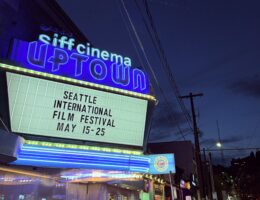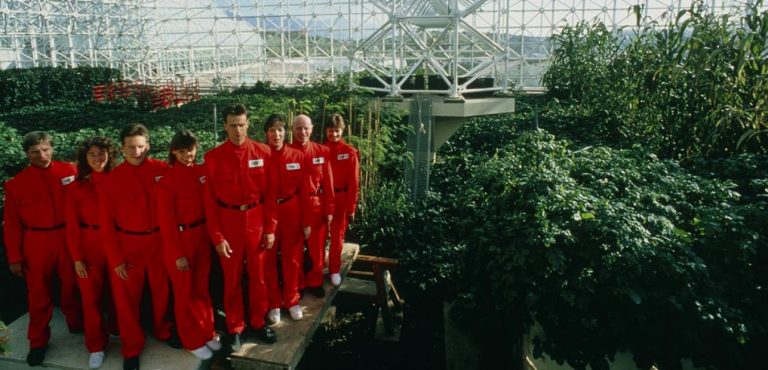Spaceship Earth (2020 | United States | 113 minutes | Matt Wolf)
When eight “Biospherians”, clad in their Star Trek-inspired jumpsuits, locked themselves inside a giant terrarium in the middle of the Arizona desert in 1991, I was a kid. I remember being awestruck by the planned two-year endeavor, in which they’d carry out their lives in relative isolation, drawing sustenance from the meticulously-constructed biomes within the great glittering glass structure. From far away and through naive eyes, this ambitious project in the Mars-approximating Sonoran desert seemed like pinnacle of scientific progress, a gateway to a future, a small step before a giant leap to far away worlds. But above all, it seemed very official. Nothing in the media presentation conveyed that the whole operation was a fanciful project by billionaire-backed hippies.
And so Matt Wolf’s new documentary about the Biosphere 2 Project (the “2” indicating that the planet Earth is “Biosphere 1”) rewinds a quarter century before the airlock sealed on that 1990s experiment, back to a series of chance meetings in a San Francisco commune. Through present-day interviews, the principals reflect on their largely drug-free origins in the Bay Area (“where it was happening, planetarily”) experimental scene, hungry to capitalize on a perceived window of possibility to change history. This so-called Theater of All Possibilities sprung up around John Allen (“Johnny Dolphin”), a Oklahoman metallurgist with a Harvard MBA and a stint in the Army Corps of Engineers, about a decade older than the rest of the scene, whose world travels brought him to the center of the counter-culture revolution amid a collection of artists, scientists, and writers.
Their instinct for self-documentation serves the film well, providing contemporaneous views of began taking on increasingly complex productions. Consumers of modern documentaries with an ingrained skepticism for cult-like organizations who problem-solve through experimental drama and communicate emotions through unstructured dance and theater games will no doubt watch with increasing anticipation of catastrophic failure. Surely the touring production will flop, the farm built from scratch in a remote corner of New Mexico will go bust, the hand-made ship will sink before even leaving the harbor. But instead, time and time again, the film basically shows the surprising competence of an unconventional group to achieve their goals without succumbing to predictable pitfalls.
The tone of the film is largely neutral and respectful, Wolf seems less interested in exposing a scandals than telling the story of these people, following their entrepreneurial spirit to the point that they’re eventually hosting retreats around the world with luminaries like William S. Burroughs, Buckminster Fuller, and Rachel Carson. It’s here that their freewheeling science-fiction based speculation informed the idea to create the enclosed ecosystem, and presumably where they captured the attention of Texas oil heir Edward Bass, who became a critical partner and primary funder of their grand gesture of ecological experimental theater.
When we do get back to the Biosphere 2, one gets both a sense of the efforts involved to cultivate the sprawling complex, its various enclosed ecosystems, terrible nineties decor, and to spawn publicity. The media’s attention was captivated with the promise of celebrity ambassadors like Tom Cruise (though the film only shows footage of outtakes from an informational video hosted by Golden Girl Rue McLanahan). Once the team is locked inside, things don’t go perfectly physically (at one point, they are described as starving and suffocating) or mentally (predictable personality conflicts). All the while, tourists show up to peer through the glass, the people inside toil to produce their own food and fun, and analysts on the premises collect thousands of points of data. As the novelty wears off, outside observers noted minor scandals concerning a team member needing to leave for medical attention and another involving the air filtration system, plus a growing sense of skepticism about the scientific value of the experiment. I might have liked the film to dig deeper into these issues, but perhaps because of the close participation of the original Biospherians, Wolf remains steadily sympathetic, showcasing the beauty of the facility and the earnestness of the project’s goals while including, but not amplifying or deeply investigating, the squabbles and challenges.
When a true villain emerges from nowhere to wrest control of the project from the founders, modern viewers may gasp in shock and recognition that yes, it’s the same (spoiler) Baby Steve Bannon who spitefully overthrew an eco-collective is the same one grew up to become one of the primary architects of our current dreadful political situation. One which, indirectly, has resulted in this film being released into home viewers rather than crowded theaters. Watching the story of eight isolated adventurers in a greenhouse while stuck inside our own homes makes for an inadvertent but potent historical rhyme. Here in their future, we’re only a few months into self-isolation, but the homebound experience of Covid-19 quarantine enhances our appreciation of the challenges of two years in a greenhouse. Sure, they survived without grocery deliveries, but watching sparked a faint sense of envy that their time away from humanity included continuous access to acres of diverse plant and animal species, all sealed off from airborne viruses. A walk through a jungle without a mask or swim above a living coral reef sounds pretty great right about now.
Spaceship Earth is available for home viewing through a partnership between NEON and independent theaters around the country, including SIFF Cinema. For the full festival experience, a series of Q&As were taped during opening weekend and are also available via Neon.



